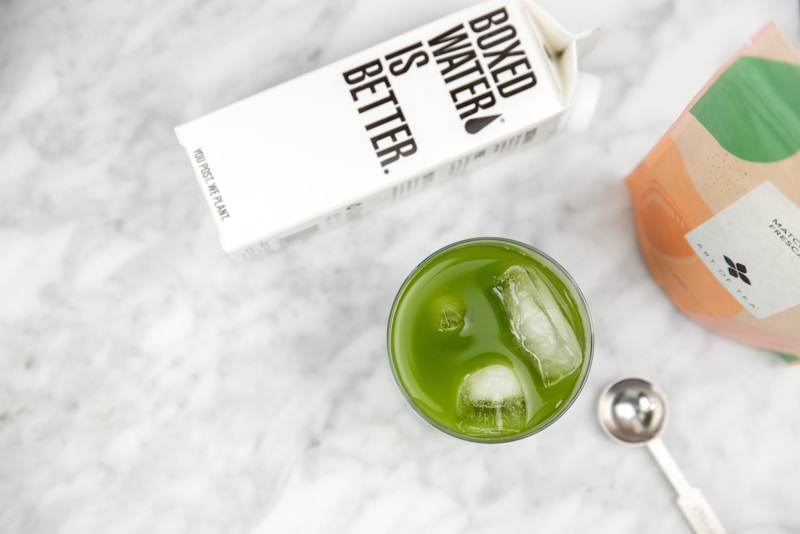There is so much nutritional information out there about how to eat healthily that sometimes it can be confusing to know what to eat to ensure your body and mind feel good. Here, nutritionist and yoga teacher Elisa Pineda takes a look at the science behind some of the most common mistakes yogis can make when trying to eat healthily.
1. Juice Drinking
One of the greatest mistakes that yogis can make when trying to eat healthily is to substitute good old fruit and vegetable eating with a juice. A juice is not a meal replacement. It’s mostly composed of fast-absorbing carbohydrates and the vitamin and mineral content suffers greatly through the extraction process.
When extracting juice from fruits and vegetables there is a loss of fibre and minerals. The process also exposes the nutrients to oxygen for a longer time than if you were to eat them in their natural state. A good example of this is vitamin C. When in contact with air oxidises and loses its antioxidant properties. The result is a sugary drink with poor nutrient content.
With many of us living fast-paced lifestyles, we’re often lacking the time to properly prepare and enjoy our food. This is where juices come in as a quick fix when trying to eat healthily. A healthier alternative would be to eat fruits and vegetables in their natural state, instead of processing them.
Of course, it doesn’t mean that once in a while you can’t enjoy a juice. One hundred percent vegetable juices can be great way of getting your 5-a-day. However, it’s important to consider that you are not obtaining the full benefits from a juice, compared to if you were to eat your vegetables whole.
2. Food Trends And Fads vs Trying To Eat Healthily
Amongst the healthy eating and wellness industry, there always seems to be a new trend or research telling us to try a new product, diet or approach to eating.
Examples of such trends include the Atkins diet that was made famous in the noughties when we were told to eliminate carbohydrates from our diet to lose weight quickly. The Slim Fast drinks are another example that pioneered the meal-replacement trend. More recently, ‘superfoods’ such as coconut oil, kale and raw food diets are prevalent amongst nutritional advice.
Before embarking on a new approach to eating, it’s helpful to consider the following questions:
- Does it seem too good to be true?
- Who is providing the information? Do they have something to gain commercially? Who performed the study (are they reputable?)
- Are there other studies that support this information?
The following table can help you discern between what is realistic and healthy vs what could be a fad:
A healthy diet… |
A fad diet… |
| Promotes healthy dietary patterns that meet nutrient needs, includes a variety of foods, suits your food preferences, and can be maintained throughout your life. | Limits your food selection to a few food groups or promotes specific rituals (e.g. only eating specific food combinations) resulting in a limited nutrient content and variety. |
| If you are looking to lose weight, it would promote a reasonable weight loss of 1 kg/week and would not restrict your calories below 1200/day which is your basal energetic requirement. | Promotes rapid weight loss of much more than 1kg/week. |
| Promotes or includes physical activity. | Advertises weight loss without the need to exercise. |
| Is flexible enough to be followed when eating out and includes foods that are easily obtained. | May require a rigid menu or to avoid certain foods or include magic foods that promise to burn fat or speed up your metabolism. |
| Does not require costly supplements. | Motivates you to buy special foods, expensive supplements or other health related products. |
| Promotes a change in behaviour. Teaches you helpful eating habits and provides social support. | Does not recommend any changes in physical activity or behaviours or might recommend a dietary pattern that is difficult to maintain on a daily basis. |
| Is based on sound scientific principles and can include monitoring by qualified health professionals. | Makes unscientific claims instead of being based on clinically tested or scientifically proven claims. Might claim that it is a new discovery and relies on testimonials. |
3. Skipping Meals
We have all heard of the claimed benefits of fasting – to lose weight or to try and cleanse and detoxify the body. Fasting has been used for religious and spiritual purification for centuries. As far back as the Old and New Testaments of the Bible to the Quran and the Upanishads, periodical fasting was as a rite of spiritual purification.
But what about when we go overboard? Fasting can go wrong when we try to replace everything that we didn’t eat in the morning with all of our accumulated cravings in the late evening.
Science indicates that there is no evidence to support fasting as an effective method to lose weight. It can actually have the opposite effect, leading to weight gain. Fasting can result in fluid loss, rather than actually body mass loss. It’s also very likely that this loss will return quickly as soon as you re-establish your regular meals.
Fasting is not a weight loss tool – it slows your metabolic rate down so that your body tries to compensate for the energy loss. It can be actually be quite dangerous if you have any problems with your liver or immune system.
There is no scientific evidence that fasting it will detox the body. The issue of fasting to cleanse the body has no biological basis because the body is really good at that by itself. The liver, along with the lungs, colon, kidneys and skin are natural detoxification centres and all work to remove toxins from your body naturally.
4. Too Much Of The Same Thing
‘Too much of a little thing can be wonderful’ says Nigella Lawson. This may be true for our taste buds and temporary wellbeing, but I would say that a little bit of everything can be wonderful. Good nutrition comes when we learn to balance the different nutrients in every meal. The nutrients available in whole foods (ie those that are not processed) work symbiotically to provide us with exactly what the body needs to achieve homoeostasis (its natural state of balance).
Whenever I teach a nutrition class I begin by asking my students what they think is the key to healthy eating is. My answer is always the same: variety, balance and moderation.
Variety
- Eating foods from a variety of food groups
- Eating a variety of foods within each food group
- Benefits: increased nutrients and phytochemicals (plant compounds), decreased toxins
Moderation
- Moderate portion sizes
- Moderate consumption of each food
- Benefits: not too much of any nutrient or calories
Balance
- Balance unhealthy choices with healthy choices
- Balance calories taken in with calories burned
- Balance foods within food groups
- Benefits: wider variety of nutrients and weight control
5. Extreme Supplementing
The use of some supplements such as spirulina or algae for example could bring some negative consequences to your health. These supplements do not go through standardised regulations and the content of heavy metals due to their marine nature could be high.
If you want to boost your immune system or are just looking for better health, it is better to obtain this from whole foods.
Relying on vitamin and mineral supplements is inadvisable – they are not as well absorbed as they are when they are naturally packed within your food. What’s more, they need help from other nutrients to be absorbed.
For instance, vitamin A is absorbed with the help of fatty acids. Foods such as carrots, dark leafy greens, sweet potatoes or squash (all rich in vitamin A/Carotene) are all rich sources of this. By combining them with sources of fat such as olive oil, avocado, nuts and fatty fish like salmon you can enhance the absorption of vitamin A in your digestive system.
6. Going Gluten Free
The gluten free food market has grown dramatically in the last few years, and is now thought to be worth over £200m. More and more of us are adopting a gluten free diet without a medical need for it.
Gluten is a general name for the proteins found in wheat, rye, barley and triticale – a cross between wheat and rye. Gluten helps foods maintain their shape, acting as a glue that holds food together. There is nothing wrong with gluten in itself, in fact many whole grains are rich in vitamins and minerals, such as vitamins B and D and iron and fibre.
The problem occurs when your body does not have the right tools to digest it. Coeliac disease, a serious genetic autoimmune disorder where the ingestion of gluten leads to damage in the small intestine is estimated to affect 1 in 100 people. Medical gluten intolerance or the skin condition dermatitis herpetiformis can also make sufferers react badly to gluten.
If there is no medical need to avoid it, gluten-free products can even be higher in fat, sugar and salt than regular foods. This is due to a need to improve their flavour or texture in the absence of gluten. Not only that, but by excluding whole groups of foods, you are putting yourself at risk of lowering intakes of certain vitamins and minerals. By cutting out gluten without a medical need to, you are reducing your intake of whole grains, a key source of fibre in the diet and something most of us don’t get enough of.
7. Always On The Go
We need to remember that eating is not only a physiological need but also a social and enjoyable activity that we need in our lives. Giving yourself time to really enjoy your meal, away from the computer or phone screens can make a big difference to your digestion and your general health.
Research has indicated that people who are relaxed whilst eating are more likely to have a better nutrient absorption. So practice your yoga philosophy on the table and stay away from eating meals in a hurry.
8. Uninformed Veganism
A great mistake many yogis make when trying to eat healthily is going vegan without doing their homework first. If you decide to take this road be sure to inform yourself of the alternatives and ways of balancing your diet. The greatest deficiency in vegans is not protein but vitamin and mineral deficiency like B12 and iron. The good news is that there are supplements that you can take, but as I previously mentioned they are better absorbed from natural foods. Examples are the peel of fruit and vegetables, pulses and
9. Going All ‘Natural and Organic’
You may have heard about pesticides danger. Organic farmers, on the other hand, use synthetic and natural kinds of pesticides with approval under the USDA Organic Act. It’s important to note that natural pesticides are not necessarily safer than synthetic ones.
So, what to do when trying to eat healthily? More scientific evidence is required to understand the possible effects of the synthetic and natural pesticides being used. Both organic and non-organic food productions have their pros and cons. However, all food in the UK is safer than ever before. The media and the industry can use food scares and misinformation as a tactic to increase sales. As consumers we have to be weary of these strategies keeping in mind, that more than organic, a balanced diet is what we need in our lives.
Organic doesn’t necessarily make your diet healthy, rather it is the actual balance of foods that you include in it.
For more information on organic products in the UK and Europe please check the UK’s Government website and the Soil Association and LCAs studies.
10. Going Hungry After Yoga
After you have warmed up, stretched, and cooled down, the body needs some replenishing. To prevent injuries, promote fibre regeneration, enhance recovery, allow for muscle growth and maintenance you need to eat food within the first two hours after yoga. This is the time when the muscles are more susceptible to absorbing glucose.
To wrap up – there is nothing better than a balanced and healthy diet, with nutrients gained naturally from whole foods that also includes yoga or regular physical activity.
There are no tricks or shortcuts to wellbeing and attempting quick fixes is more likely to unbalance your body. The key is to bring variety, moderation and balance to your diet and lifestyle.













